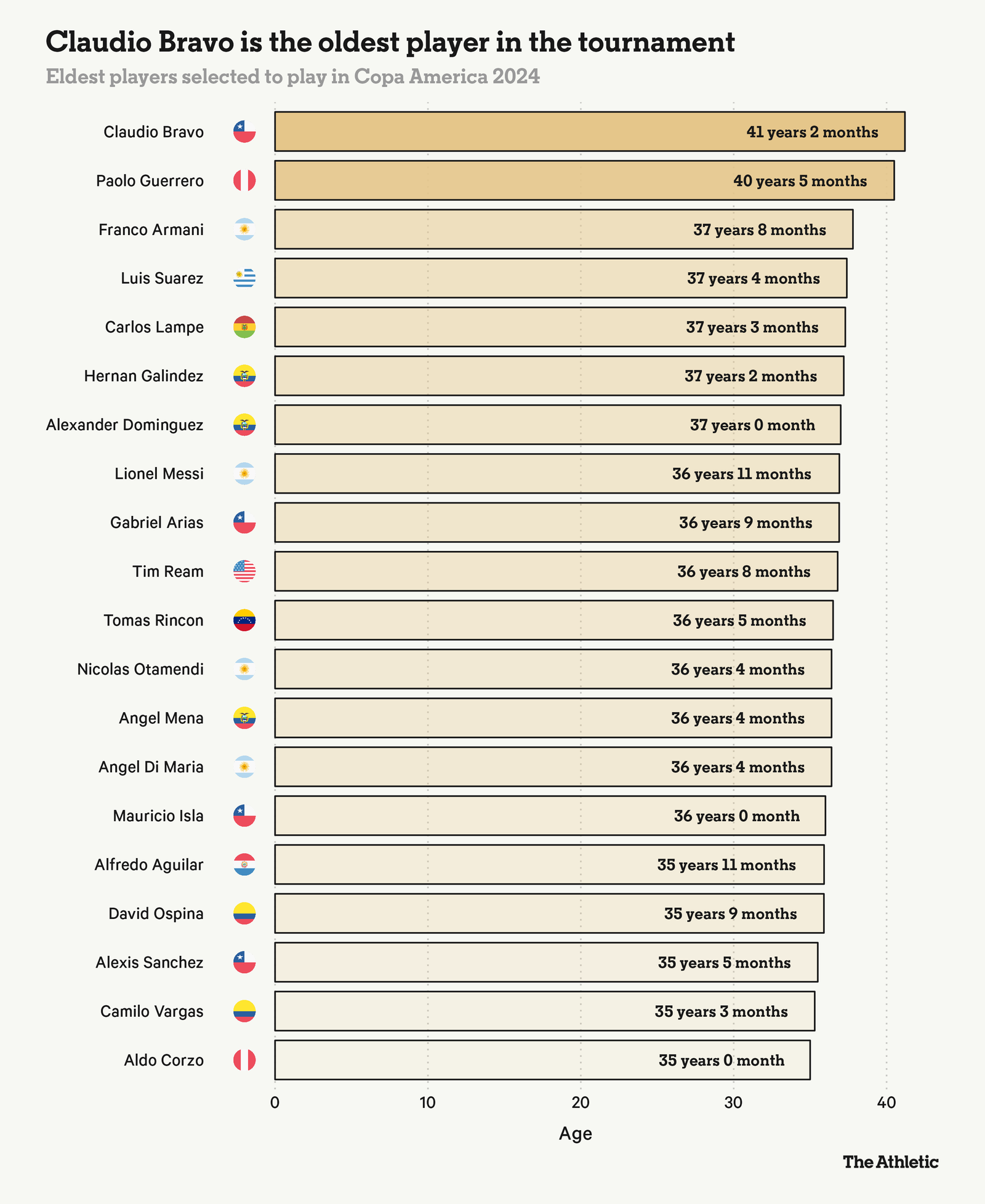Records will tumble at this summer’s Copa America.
For just the second time in its 108-year history, South America’s continental competition will take place outside of the motherland. The United States will host, Canada make their tournament bow, while Mexico will appear for a record fifth time as invited guests ahead of the World Cup in North America in 2026.
We could also have a new oldest player, a second-youngest goalscorer, and an undisputed record title holder, with two of the tournament favourites tied on 15 Copa America crowns apiece.
The Athletic dives into all the numbers, whether revealing, random or downright ridiculous.
How to follow the Copa America and European Championship on The Athletic…
The golden oldies
Plenty of South America’s iconic figures will surely be playing their final international tournament this summer, while others have already missed the cut. Chile’s Arturo Vidal, Colombia’s Radamel Falcao, Uruguay’s Edinson Cavani and Brazil’s Thiago Silva are just a handful of names who will not be representing their countries in the States after decades of loyal service.
Peru and Chile, two of the most successful Copa America sides throughout the 2010s, will defend their excellent recent records with the oldest squads in the competition. At an average age of 29.1 years, even without Yoshimar Yotun (128 caps) and Renato Tapia (85 caps), five of Peru’s 10 most-capped players will be vying for their place in the starting XI.
Zooming out and a glance through the older names on the squad lists feels like a trip down memory lane, with big-hitters Luis Suarez, Lionel Messi, Angel Di Maria and Alexis Sanchez all likely to say their emotional goodbyes to competitive international football in July.

Those are not the only notable names; 40-year-old Paolo Guerrero needs just three goals to equal the all-time scoring record at the Copa America, while Messi is only four behind and needs just one more game to break Sergio Livingstone’s record of 34 appearances at the competition that has stood for 70 years.
Goalkeeper Claudio Bravo will become the oldest player in tournament history, heavily favoured by new Chile head coach Ricardo Gareca despite over seven months without an appearance at club level for Real Betis. At 41 years, two months and 16 days, there are 10 players available for selection this summer who were not even born when Bravo made his international debut in 2004.
A word for the CONCACAF nations, too. Joel Campbell is still only 31 years old but will break the 140-cap barrier for Costa Rica in Group D, one of the last remaining players from their historic World Cup run in 2014 after Keylor Navas announced his shock retirement in May.
Such generational change is reflected in the squad-wide data; Gustavo Alfaro’s side boasts the youngest average age of any team ahead of the tournament at just 24.7 years, with 13 players aged 23 or below — more than any other nation this summer.
Panama’s 34-year-old Anibal Godoy will marshal the midfield with his usual poise, but do not expect to see the iconic 38-year-old Guillermo Ochoa guarding Mexico’s goal; he was dropped from the squad alongside fellow thirty-somethings Raul Jimenez, Hirving Lozano and Jesus Gallardo as El Tri look to the future with a home World Cup on the horizon.
Times are changing, tune in before it’s too late.
The next gen
There are two outstanding youngsters to keep an eye on this summer and both could have big roles to play.
Chelsea-bound Kendry Paez is fearless and fizzing with confidence, a fleet-footed dribbler who loves to cut inside onto his left foot and strike from distance. He has already scored and assisted for his country in World Cup qualifying, plays a starring role for Independiente del Valle, and will be a key spark for an Ecuador side struggling to consistently create at the sharp end of the pitch.
Some nine months ahead of his development path is Endrick, who now has three goals in four substitute appearances for Brazil, including winners against England and Mexico. He will be pushing for a starting berth, but for now, both his instinctive finishing ability and frightening bursts of acceleration and power around the box are game-breakers against tired legs.
Further down the list, there is lots of excitement surrounding Chile’s Dario Osorio, an elusive winger with a thumping left-footed strike, while Brighton’s Julio Enciso, despite a six-month meniscus injury, may have to shoulder the attacking responsibility for his native Paraguay, who have scored just twice in their last nine games.
Talk about a baptism of fire.
Most experienced squad
Not only current holders and reigning World Champions, Argentina are also the most experienced nation based on the average number of caps per player in the squad.
Granted, that average is pulled up slightly by Lionel Messi, whose 182 caps for his country are more than any other player in the tournament this summer.
Fellow 36-year-olds Angel Di Maria and Nicolas Otamendi also boost their nation’s average, with 140 and 112 caps respectively, completing the trio of Argentina players with 100-plus caps. Only Chile, with four centurions in the side, have more.
Brazil are surprisingly light on the caps front; their record appearance maker is Marquinhos, with 85. Otherwise, 23 of the 26 players selected have fewer than 50 caps, while 15 have fewer than 10.
They are the outliers in a group of the five least experienced sides, all rank outsiders to progress. Bolivia have won one game in their last seven Copa Americas, a 3-2 win over Ecuador in 2016, which is also their only competitive win away from their high-altitude fortress in La Paz in the past 29 years.
In terms of title wins, two are clear of the rest.
Argentina and Uruguay are tied on 15 titles each, six clear of Brazil, and both look more than capable of going all the way.
Best goals-per-cap rate
Goals are what we are really here for, aren’t they?
We want to see the best players scoring the best goals on the international stage, so it is worth looking at who is the most prolific for their country among all players in the tournament.
That player is… Messi.
The best player on the planet will be familiar with football in the United States since his move to Inter Miami in July 2023 and he will more than likely add to his tally of 108 Argentina goals this summer to become the outright second-most prolific international player in men’s international football history.
Jonathan David’s numbers stack up well with some of the continent’s legendary strikers, with seven of the players in the graphic above (Messi, Suarez, Enner Valencia, Cyle Larin, Salomon Rondon, Guerrero and Sanchez) starting the tournament as their nation’s record goal scorers.
There are plenty of players who know how to find the back of the net.
And the managers…
You would be forgiven for being slightly out of the loop on the Copa America’s head coaches — 11 of them have been in the job for less than 18 months.
The most recent appointment of all was that of Jesse Marsch, hired as Canada boss just 39 days before their tournament opener against Argentina. He is one of three former Leeds United managers in the tournament, along with Marcelo Bielsa of Uruguay and Thomas Christiansen of Panama.
Curiously, seven of the 16 managers at the tournament are Argentinian, while four are over 60 years of age — Peru’s Jorge Fossati is the oldest at 71 and is affectionately named “El Nonno” or “The Grandfather”, while Dorival Junior has managed 12 of the 20 sides currently in the Brazilian top flight.
What they lack in experience on the pitch, they more than make up for on the sidelines.
Read the full article here

